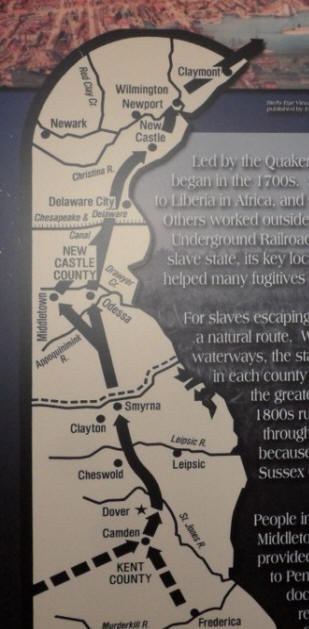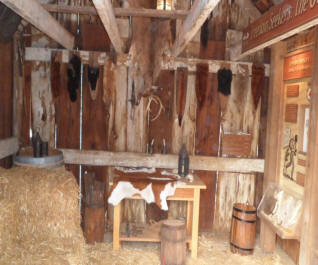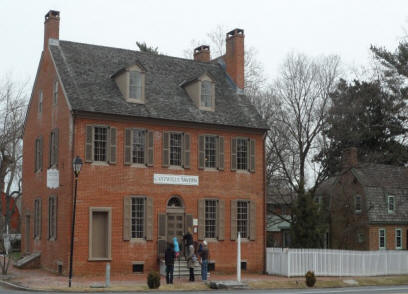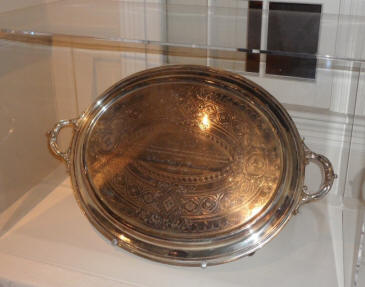|
DELAWARE'S CORRIDOR OF COURAGE
Ren�e S. Gordon
"Thou hast left me a dollar, but I wish to say to thee, and all in the
courtroom, that if anyone knows of a fugitive who wants a shelter and a
friend, send him to Thomas Garrett."
The course of both slavery and abolitionism in Delaware was directed
largely by three factors, its geographical position as a border state,
the fact that no labor-intensive year round crop flourished there and
the religious influence of the Methodists and the Quakers. There were
never the large plantations, or numbers of enslaved, that developed
deeper south, the largest owner having less than 70 enslaved workers. A
single slave arrived in 1639, "Black" Anthony, the first black
documented resident, aboard the Vogel Grip. At some point he was freed
and by 1648 he was serving as the assistant of Governor Printz. By 1750
the number increased to 1,000 and on the eve of the American Revolution
there were 2,000. The 1779 federal census records 8,887 slaves and 3,899
free blacks. Immediately prior to the Civil War there were less than
2,000 slaves and 19,829 free blacks in the state.
 |
| A bible with slave inventory |
Though the number of slaves was initially small the first sign of alarm
at the increase was sounded in 1700 when the "Act for the Trial of
Negroes" was enacted placing severe restrictions on behavior and
outlining harsh punishments for violations. In 1776 a law was passed
that prohibited the sale of a Delaware slave out of state and banned
their import into the state making Delaware the first state to attempt
to limit the trade.
www.nps.gov
Delaware's Harriett Tubman Byway Underground Railroad route (UGRR) is
often referred to as a "corridor of courage" as indeed it was for both
those who assisted freedom seekers and the freedom seekers themselves.
Traveling the basically south to north UGRR's 150-mile Eastern Route
began in Maryland's Eastern Shore into Delaware through Camden, Odessa,
Dover, Middleton, New Castle, Wilmington and to Philadelphia. Modern
travelers can follow this route and, though many of the sites are no
longer extant, visit and view 14 sites that figured prominently in UGRR
history.
www.harriettubmandelaware.com
 |
| Map of Delaware's UGRR |
The tiny city of Camden was originally a 112-acre Quaker colony founded
in 1789 on the property of Daniel Mifflin. His brother Warner is
credited as the inspiration for the manumission of many of the state's
early slaves when he was the first to free his slaves in 1794. Warner
was Delaware's delegate to the first convention of the Abolition
Societies of the United States held on January 1st in that
same year.
In 1804 residents built the Camden Friends Meeting House on land donated
by the Hunn family. They were known as both early abolitionists and
philanthropists. The interior of the meetinghouse has several notable
features. There is a wooden panel at the rear that could be lowered to
allow any overflow attendees to sit on the stairs and participate. A
school was located on the second floor and some of the furnishings are
original.
John Hunn, referred to as the chief engineer of Delaware's
UGRR, was caught with escaping slaves and, after a full assessment of
his holdings, was fined to the last penny. Little documentation remains
of his work because his deathbed wish was for all his papers to be
burned. He is buried in the adjacent graveyard. Great Geneva, Hunn's
childhood home, and Wildcat Manor, the family property, remain standing
under private ownership.
Dover, Delaware, 62-miles from Philadelphia, was a very important area
on the journey and has one of the premier sites in the state. Woodburn,
the official governor's residence since 1965, was constructed in the
1790s by Quaker Charles Hillyard III. In the 1840s and 50s the Georgian
house was a station on the UGRR during the ownership of Daniel Cogwell.
It is believed to have been the largest stop in the nation. Fugitives
were hidden throughout the house and were treated as family members.
www.woodburn.delaware.gov
The John Dickinson Plantation provides an outstanding overview of
colonial and revolutionary Delaware as well as an orientation to
plantation life, the institution of slavery and the people involved in
the struggle against it. Costumed guides tell these stories as visitors
tour the mansion and grounds.
Samuel Dickinson built the original brick 3-story Georgian house in
1740. In 1760 John inherited the house, 5,000-acres and between 30 and
60 slaves. In 1777 John conditionally freed his slaves, they had to
learn to read and write, and in 1785 he unconditionally freed them. "A
World Apart," an interactive group tour interprets the lives of the free
and enslaved African Americans and indentures. Admission is free.
www.history.delaware.gov
The house burned in 1804 and with one of the country's first insurance
policies was reconstructed. The roofline was altered and the rebuilt
house had only 2-stories. Tours of the interior showcase original doors,
Caesar Rodney's desk and 18th-century original furnishings.
Several rooms feature wax figures of the enslaved. Exterior tours
include a log, 1-room, cabin of the type inhabited by slaves, indentures
and the poor of the era.
 |
 |
| Docent at Dickinson House |
Slave cabin at Dickinson House |
John Dickinson is recognized as the "Penman of the Revolution" because
he helped write the first draft of the "Articles of the Confederation."
He was also a signer of the "U. S. Constitution." Dickinson College is
named in his honor.
Delaware's three lower counties were considered part of Pennsylvania
until June 15, 1776 when Delaware became a separate state. As part of PA
William Penn left plans for The Dover Green in 1683. The plans were
carried out in 1717 and the result, 296-years later, is the Green within
a 16-site First State Heritage Park. Since 1777 the area has been the
site of state government featuring the State Capitol and the State
Supreme Court.
www.destateparks.com/heritagepark
 |
| Dover's Old State House |
The Georgian first permanent state capitol was erected in 1791 and
functioned until 1933. The Old State House tour is a wonderful
combination of guided tour and re-enactments. On the second level
visitors can view the House of Representatives with a public gallery. In
this space emancipation legislation was defeated in both 1803 and 1847.
In 1862 Lincoln decided to test his plan to pay slaveowners for freeing
their slaves in Delaware. He was going to pay $500 per slave, more than
the going rate, to end the Civil War. They refused to even bring it to a
vote. Delaware did not ratify the 13th, 14th and
15th amendments until 1901.
In the courtroom on the first floor interpreters relate stories of how
legislation affected blacks in general and relate the story of Samuel
Burris a free black conductor caught in the act. He was sentenced to be
fined, confined and upon completion of his sentence enslaved and sent
south. While serving his sentence he wrote to abolitionists for
assistance to no avail. His sale took place on the Dover Green. He was
purchased and tossed in a wagon for the journey. After a few miles his
new owner stopped, freed him and told him that the abolitionist had
heard his pleas and he was now free. Burris moved to California and
never returned to Delaware.
Adjacent to the Old State House is the Supreme Court building, once the
home of the Chew family. They owned 63 slaves and were the largest
owners in the state.
The Dover Jail was once located on the Green. It was here that 8 freedom
seekers were lured and nearly captured. They made a successful escape
and two later joined John Brown's forces.
www.visitdover.com
 |
| Muskrat Skinning Shed |
Historic Odessa is the site of 2 buildings on the UGRR Network to
Freedom. The village was once a river port known as Cantwell's Bridge
but was renamed after a Ukrainian port city. This tiny jewel is a
historic district with five distinctive structures.
www.historicodessa.org
An UGRR tour begins in the visitor center with an 8-minute orientation
film and proceeds to the 1774 Philadelphia Georgian Corbit-Sharp House.
The history of area slavery and abolitionism is recounted in an
authentic muskrat-skinning shed filled with artifacts, displays and
facsimiles. Inside the house visitors can climb to the attic and view
the documented hiding place where the family hid a slave. Also in the
attic is the premier artifact on display, a 1750 Bible that belonged to
the Coates family of Culpepper, Virginia. Written on the pages of the
Bible are slave lists. Fifty percent of the furnishings are family
pieces.
Cantwell's Tavern, in what was the 1822 Brick Hotel, is a wonderful
place to stop for lunch. The food and service are outstanding.
www.cantwells-tavern.com
The Appoquinimink Friends Meetinghouse is said to be the smallest in the
country. The red brick, 20-ft sq. structure was built in 1793 by David
Wilson and gifted to the community. It is believed the fugitives were
hidden in the loft and that Harriett Tubman stopped there.
 |
| Cantwell's Tavern |
Thomas Garrett's trial was held in the New Castle Courthouse and his
story is interpreted there. Garrett was accused of stealing the Hawkin's
family and was fined his entire fortune.
The first courthouse was constructed in 1689, this one dates from 1732,
and the court replicates a colonial English courtroom on the first
level. On the second floor there is a permanent display on slavery in
Delaware and a life-sized diorama of the incarcerated Harris family
awaiting trial. The history of Delaware is traced here through
portraits, paintings and a model of the original fort.
Thomas Garrett, the
"Stationmaster of the Underground Railroad," was one of the most
important figures in the history of the UGRR. Born in Philadelphia in
1789, Garret Road is named in his honor, he moved to Wilmington in 1822.
He worked tirelessly in the cause of abolition for 38 years and assisted
2,700 freedom seekers. Upon his death in 1871 African Americans attended
his funeral in record numbers and bore his coffin to the gravesite at
the Wilmington Friends Meetinghouse.
The original Wilmington Friends Meetinghouse was erected in 1738,
followed by a larger structure in 1748, on Quaker Hill. The current
building was erected in 1816. When Garrett was fined his entire fortune
and forced to sell his personal property as well as his iron and
hardware businesses. Friends from this meetinghouse purchased his
businesses and returned them to him. He repaid them. John Dickinson is
also interred in the adjacent cemetery.
 |
| Tray belonging to Garrett |
"Distinctively Delaware" is on permanent exhibit in the Delaware History
Museum and that display and others paint a clear picture of the state's
history. A highlight of a museum tour is the large silver tray given to
Thomas Garrett in 1866 by the black community and in gratitude.
Immediately adjacent is the Georgian Old Town Hall. A small display on
the UGRR is located on the first floor. Steps on the side of the
building provide access to original jail cells and the sheriff's office.
Interestingly, the first escapee was a black male.
Tubman and Garrett often worked in tandem and Tubman-Garrett Park in the
Riverfront has chosen to pay homage to them both with a splendid
sculpture, "Unwavering
Courage in the Pursuit of Freedom."
www.visitwilmingtonde.com
Our final stop is Longwood Meetinghouse across the PA line. This radical
group of Quakers assisted fugitives in many ways and was often visited
by prominent abolitionists of the day. Here you can arrange a guided
tour of the Kennett Square UGRR sites.
Information
on all sites is available online.
www.visitdelaware.com
Travel Tip:
Harriett Tubman will be present in the person of Dr. Daisy Century on
May 4th at the 80th Annual Dover Days Festival.
Mark your calendar for that and all of the Harriett Tubman 100th
anniversary events.
www.harriettubmanandelaware.com
For more about Delaware see
Art Trails
|





















